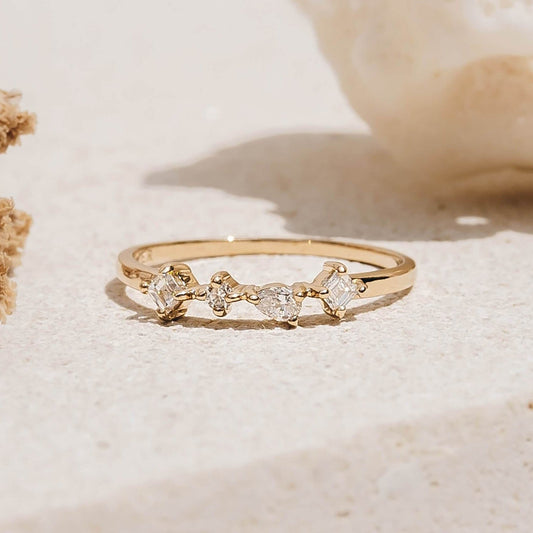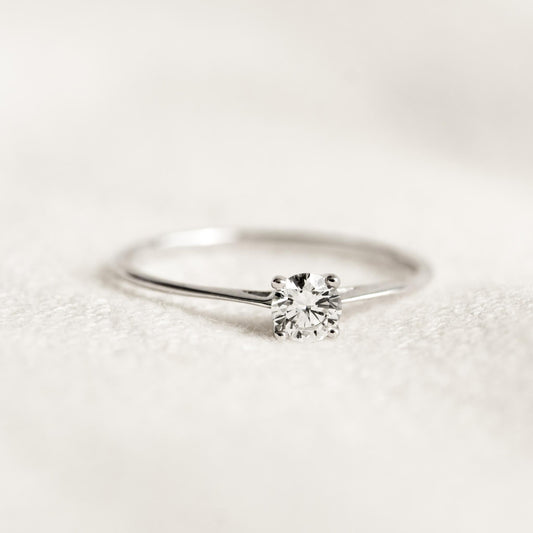14k Gold: Your Complete Guide | Linjer Jewelry
What is 14k gold?
14k gold is a gold metal alloy that contains 58.3% of pure gold and 41.7% other metals. So, why isn’t gold 100% gold? Why 58.3%, isn’t that kind of a random number? As it turns out, there’s a satisfying explanation.
So, to answer the question, “Why not 100%” gold?: Well, 100% pure gold is a very soft metal (Mohs 2.5), making it extremely easy to scratch and bend, and it’s a bit pricey. Understandably, you might not be inclined to hand over a few thousand dollars for a piece of jewelry that’s probably going to get scratched and bent out of shape.
So, jewelers have come up with a great solution: Gold metal alloy, which is a mixture of gold and other more sturdy metals. As long as a gold-based metal alloy contains at least 41.7% pure gold (that’s 10k), it can be legally labeled and sold as solid gold.
Shop our 14k Gold Jewelry
What is the purity of 14k gold?
14k gold contains 14 parts pure gold and 10 parts other metals, making it (14 divided by 24) 58.7% pure gold and 41.3% other metals.
Here’s a simple breakdown of standard karats of gold:
- 10 karat: the gold to total material ratio is 10/24 or 41.3/100; this can also be called 413 gold
- 14 karat: the gold to total material ratio is 14/24 or 58.7/100; this can also be called 587 gold
- 18 karat: the gold to total material ratio is 18/24 or 75/100; this can also be called 750 gold
- 24 karat: the gold to total material ratio is 24/24 or 99.9/100; this can also be called 999 gold
Different Types of 14k Gold
The different types of 14k gold refer to the different colors that the gold can be made into by alloying it with other metals. The most common types of 14k gold are 14k white gold, 14k yellow gold and 14k rose gold:
- 14k white gold is created by alloying pure gold with white metals such as silver or palladium, giving the gold a silvery-white appearance.
- 14k yellow gold, on the other hand, is alloyed with copper and silver, which gives it a warm, yellow tone.
- 14k rose gold is created by alloying the gold with copper, which gives it a reddish-pink hue. The specific combination of metals used in the alloying process determines the final color of the gold, allowing for a range of beautiful and unique options.
How to Identify 14k Gold
The easiest way for consumers to identify 14k gold is by checking for the hallmark or engraving. In many countries, jewelers and metalsmiths are required to stamp gold alloy with its karat count or purity percentage. So, you can check for a “14k” or “583” stamp. (Psst…if you see a mark like “GP,” that means the piece is gold-plated and not solid gold.)
If for some reason you can’t find the hallmark, that doesn’t mean it’s not gold. There are some other ways to identify 14k gold, but be careful with home tests—like the float test, vinegar test, or certain scratching tests—as they can ruin your jewelry, and they aren’t always accurate. If you don’t see the hallmark, the next best choice is to take the piece to a jeweler, who will have access to various testing methods and be able to perform them safely without harming your jewelry. Or, if you must do it yourself, opt for a professional kit.
Is 14k gold real?
Yes - 14k gold is real gold, and it can be legally marketed as solid gold! 14k gold is a homogenous mixture of gold and other metals such as copper, silver, and zinc, used to increase its strength and durability. 14k gold is a first-rate choice for jewelry as it is more affordable than higher karat golds while still having a significant amount of gold content. It is also less likely to scratch compared to higher purity golds.
Shop our 14k White Gold Jewelry
Is 14k gold good quality?
Yes - 14k solid gold is high-quality and an excellent option for fine jewelry. Its starting prices are much more friendly than higher karat golds; also, its specific proportion of alloyed metals also makes 14k gold less susceptible to wear and tear, ideal for daily use. With a 58.3% pure gold content, 14k gold is intrinsically valuable and befitting of fine jewelry. Another attraction of 14k gold is its particular hue: some gold jewelry enthusiasts love the soft, warm golden tone particular to 14k. It’s not quite as muted as 10k gold, yet it has a slightly more mature feel than 18k or 24k gold.
Durability of 14k Gold
14k is (almost literally) the golden average of solid gold alloys when it comes to longevity and durability. Remember, pure gold, while very valuable, is too soft for regular use. 18k (75%) gold retains a good deal of that intrinsic value… and a good deal of the softness too. 10k gold, while definitely the most durable, is, of course, less valuable, and doesn’t have quite the same rich gold coloring.
At just over 50% pure gold, the other “half” of the 14k gold alloy (commonly a mix of copper and silver), gives it a great durability factor and makes it far less likely to scratch or bend. Still, these metals don’t take away too much value, and they give 14k gold an elegant color. That’s why you’ll often see jewelry designed for everyday use—like a gold wedding band—in 14k gold. With the right care, your favorite 14k solid gold pieces will easily last a lifetime.
How long will 14k gold last?
With proper care, 14k gold is an heirloom quality precious metal that can be passed down to your loved ones. Of course, factors like exposure to chemicals, harsh cleaning techniques, and physical damage can all affect the lifespan of 14k gold jewelry. So, be sure to store it properly—in a dry place against a soft surface—protect it from sweat and chemicals, and clean it regularly with a soft cloth and mild soap and water (no abrasive materials).
Advantages of 14k gold
Choosing 14k gold has a host of benefits.
- First, 14k is a valuable precious metal, yet it is much more affordable than higher karat gold alloys such as 18k or 24k. This makes it an attractive option for those who want the look of gold jewelry without breaking the bank.
- 14k gold is also more durable than higher karat gold and still relatively immune to tarnishing, making it optimal for everyday elegant jewelry.
- It is also one of the most readily available karat counts to come in a variety of colors, including yellow gold, white gold, and rose gold.
- Finally, 14k gold is usually hypoallergenic, making it a good option for those with sensitive skin who may have reactions to other metals. Just double-check that it’s nickel-free. Psst… at Linjer, all of our jewelry is hypoallergenic and nickel free!
Shop our 14k Gold Engagement Rings
Diamond Ring - Ilse Luxe |
Diamond Eternity Ring |

See Product |

See Product |
Diamond Eternity Ring White Gold |
Solitaire Diamond Ring White Gold |

See Product |

See Product |
Disadvantages of 14k gold
While 14k gold has several advantages that we love, its qualities may not be for everyone. Let’s take a look at a few drawbacks of 14k gold.
- 14k gold is not worth as much as the more expensive 18k gold, another solicited choice for fine jewelry.
- Though tarnished resistant, with time, non-gold alloys can react with the skin causing some discoloration. So, it’s important to clean and polish on a regular basis.
- For those who enjoy the bright, playful yellow of pure gold, 14k’s more refined aesthetic won’t have the same appeal.
- Finally, in some cases, 14k gold is made with nickel, so if you have sensitive skin, check that your 14k gold is nickel-free. (Rest assured, Linjer only offers nickel-free jewelry!).
Can I wear 14k gold every day?
Absolutely, 14k gold is durable enough to be worn every day. Its specific ratio of pure gold to alloymetal makes it a tough match for the dings and nicks of natural wear. But, hang on a sec, that still doesn’t give us carte-blanche to create jewelry mayhem and go rogue with jewelry care. Yes, taking care of your 14k gold jewelry still goes a long way! By avoiding exposure to harsh chemicals and removing it before engaging in activities that could cause physical damage, you’ll give your 14k gold pieces a long (and shiny) life.
Is 14k gold the best for engagement rings?
We love 14k gold, an ideal choice for engagement rings, and here’s why: Engagement rings are meant to be shown off, even every day if you want. So, you need a solid gold ring that’s up to the task, and we think 14k gold is just the candidate.
14k gold is a quality choice for engagement rings due to its durability, affordability, and classy color. Some may prefer a higher-karat gold for its brighter yellow and higher value. But, the higher price tag can also be a deterrent, and let’s not forget that more K’s can mean more scratches.
So, if you’re looking for an affordable, high-value engagement ring option with the added benefit of sophisticated coloring and scratch immunity, 14k solid gold is a perfect fit.
Should I buy 14k gold jewelry
14k gold jewelry is a stellar choice for gold jewelry—just as brilliant as its sheen, if we do say so ourselves. Of course, ultimately, you get to decide which type of gold best suits your style, needs, and budget. But, if you’re on the fence about 14k gold, remember that it offers an optimal balance between durability, beauty, and affordability. 14k is the perfect place to start for those who are new to gold jewelry and equally excellent karat count to continue curating your solid gold collection. Linjer is delighted to offer a range of gorgeously unique, 100% hypoallergenic Solid 14k Gold Jewelry options—from sustainable sources at accessible prices.
















